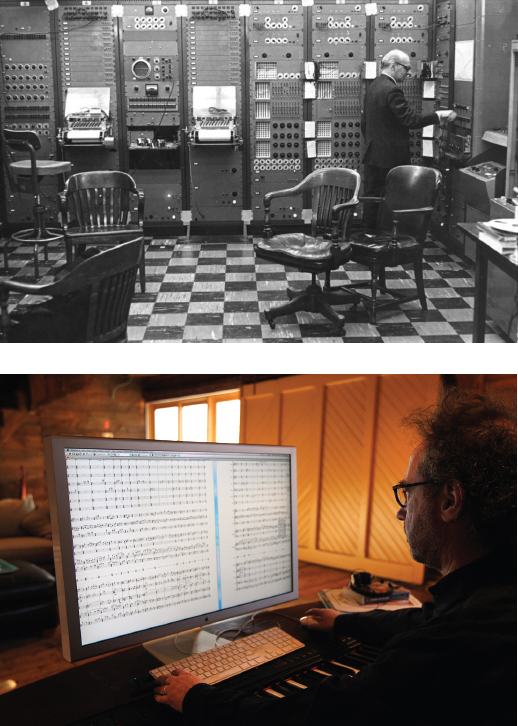Electronic Music
“I need an entirely new medium of expression: a sound-
Edgard Varèse, 1939
Recording equipment can reproduce sounds of any sort — music, speech, and all the sounds and noises of life. Electronic sound generators can do something else: They can generate sounds from scratch — in principle, any sounds that can be imagined, or calculated using formulas derived from the science of acoustics.
A technological breakthrough during World War II, the development of magnetic tape, made the storing and handling of sound much easier than before. It also opened up exciting possibilities for modifying it by manipulating the tape: making tape loops, changing speed, cutting and splicing, and so on. Across the second half of the twentieth century, we can discern three stages in the evolution of electronic music, each of them defined by new technological possibilities:
- Musique concrète Shortly after World War II composers began incorporating the sounds of life into their compositions. This they called “concrete” music because it used actual sound, as contrasted with the “abstract” products of electronic sound generators. Sounds (traffic street noise was a favorite) were recorded on tape, painstakingly manipulated, and then (usually) put on phonograph discs.
Musique concrète lives on, in a sense, in sampling, now that technology has made it easy for anything that is recorded — traffic noise, commercial records, special effects — to be put under keyboard control for easy combination.
 Electronic music, then and now: Milton Babbitt, avant-
Electronic music, then and now: Milton Babbitt, avant-gardist of the 1950s, needed a room full of equipment to create his works; for Tod Machover, a composer at the forefront of music/technology mixes today, a desktop and keyboard might suffice. Top: William Gedney Photographs and Writings, Duke University David M. Rubenstein Rare Book & Manuscript Library, http://library.duke.edu/ . Bottom: Boston Globe via Getty Images.digitalcollections/ gedney/ - Synthesizers In the first years after World War II, electronic sound generation was unbelievably clumsy, requiring whole rooms full of radio equipment and complicated machinery to carry out tape manipulations — see the photograph above. Only after the advent of transistors (silicon chips were still in the future) could viable equipment be envisaged. In the 1960s various synthesizers appeared, designed specifically for music, with arrays of sound-
producing modules connected by “patch cords” to create complex sounds. At first synthesizers worked one note at a time. Still, they allowed many composers to produce taped music and also to combine music on tape with performed live music. It was still difficult to produce customized sound in real time.
- Computer music The amazing evolution of personal computers over the last thirty-
five years has allowed for an equally amazing evolution in music. Today electronic music can be produced on a laptop, using sequencer software to record, edit, and reproduce digital sounds in patterns and sequences at will. Synthesizers can interact via computer with live musicians as they perform to produce today’s cutting- edge interactive computer music.